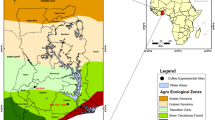Abstract
Genetic analysis of yield and morphological traits has been carried out in Coffea arabica from a half-diallel including the parental lines. The trial was established in west Cameroon with completely randomized single-tree plots. Observations included yield (four years), stem diameter, height and number of primaries. General combining abilities (GCA) and specific combining abilities (SCA) as heritabilities and genetic correlations were estimated. A significant SCA variance was observed for all the traits. Morphological traits, stem diameter, plant height and number of primaries, were genetically correlated to the yield. The hybrids were, on average, better performing than lines. There was no clear relationship between performance of lines and their general combining ability. Contribution of the seven lines to the SCA sum of squares was shown to be unequal for all the studied traits, one parent (Java) being far the most interactive. This variation of interactivity seemed to be related to different levels of residual heterozygosity among parental lines. Indirect prediction of yield using morphological traits gave the same value for expected genetic gain as the prediction based on cumulated yield over four years. The multitrait indirect selection for yield operated in a different way as far as GCA and SCA are concerned. The application of these results to coffee breeding strategies involving hybrid selection is discussed.
Similar content being viewed by others
References
Baradat, Ph., 1989. Amélioration génétique des arbres forestiers: Eléments méthodologiques. Internal document INRA, Laboratoire d'amélioration des arbres forestiers de Bordeaux, 204 pp.
Baradat, Ph. & M.L. Desprez-Loustau, 1997. Analyse diallèle et intégration de la sensibilité à la rouille courbeuse dans le programme d’amélioration du pin maritime. Annales des Sciences Forestières 54 (1): 83-106.
Baradat, Ph. & Th. Labbé, 1995. OPEP. Un logiciel intégré pour l’Amélioration des plantes pérennes. In: CIRAD-CP (Ed), Traitements statistiques des essais de sélection. Stratégies de sélection des plantes pérennes, pp. 303-330. Montpellier.
Baradat, Ph., T. Labbé & J.M. Bouvet, 1995. Conception d'index pour la sélection réciproque récurrente: aspects génétiques, statistiques et informatiques. In: CIRAD-CP (Ed), Traitements statistiques des essais de sélection. Stratégies de sélection des plantes pérennes, pp. 101-150. Montpellier.
Berthouly, M., M. Dufour, D. Alvard, C. Carasco, L. Alemanno & C. Teisson, 1995. Coffee micropropagation in a liquid medium using the temporary immersion technique. In: 16th International Scientific Colloquium on Coffee, ASIC, Japan, pp. 514- 519.
Bouharmont, P., 1994. La variété Java: un caféier Arabica sélectionné au Cameroun. Plantations, Recherche, Développement. 1(1): 38-45.
Bouharmont, P., 1995. La sélection du caféier Arabica au Cameroun (1964-1991). Documents de travail du CIRAD-CP 1 (95), 81+40 p.
Carvalho, A., 1965. Revue générale de la génétique, cytologie et amélioration du caféier. FAO Technical Working Party on Coffee Production Protection, 1st Session, Rio de Janeiro, Brazil, 3 pp.
Charrier, A., 1978. Etude de la structure et de la variabilité génétique des caféiers. Résultats des études et des expérimentations réalisées au Cameroun, en Côte d'Ivoire et à Madagascar sur l'espèce Coffea arabicaL. collectée en Ethiopie par une mission ORSTOM. Bulletin IFCC 14, 99 pp.
Cilas, C., 1995. Estimation des variances génétiques et des héritabilités pour différents plans de croisements. In: CIRAD-CP (Ed), Traitements statistiques des essais de sélection. Stratégies de sélection des plantes pérennes, pp. 71-88. Montpellier.
Crow, J.F. & M. Kimura, 1970. An Introduction to Population Genetics Theory. Harper and Row, New York, 591 pp.
Henderson, C.R., 1977. Prediction of future records. Proc. Intern. Conf. on Quantitative Genetics, 16-21/08/1976: 615-638.
Keuls, M. & F. Garretsen, 1977. A general method for the analysis of genetic variation in complete and incomplete diallels and North Carolina II designs. Part 1: Procedures and general formulas for the random model. Euphytica 26: 537-551.
Lebart, L., A. Morineau & J.P. Fénelon, 1979. Traitements des données statistiques. Dunod, Paris, 510 pp.
Searle, S.R., 1971. Linear models. Wiley, New York), 532 pp.
Sylvain P.G., 1958. Ethiopian coffee. Its significance to the world coffee problems. Econ. Bot. 12: 111-139.
Van Der Vossen, H.A.M. & D.J. Walyaro, 1981. The coffee breeding programme in Kenya: a review of progress made since 1971 and plan of action for the coming years. Kenya Coffee 46 (541): 113- 130.
Walyaro, D.J., 1983. Considerations in breeding for improved yield and quality in Arabica coffee (Coffea arabicaL.). Doctoral thesis, University of Agriculture, Wageningen, The Netherlands, 121 pp.
Walyaro, D.J. & H.A.M. Van Der Vossen, 1979. Early determination of yield potential in Arabica coffee by applying index selection. Euphytica 28 (2): 465-472.
Wricke, G., 1962. Uber eine Methode zür Erfassung der oekologischen Streubreite in Feldversuchen. Z. Planzen Schutz 47: 92-96.
Author information
Authors and Affiliations
Rights and permissions
About this article
Cite this article
Cilas, C., Bouharmont, P., Boccara, M. et al. Prediction of genetic value for coffee production in Coffea arabica from a half-diallel with lines and hybrids. Euphytica 104, 49–59 (1998). https://doi.org/10.1023/A:1018635216182
Issue Date:
DOI: https://doi.org/10.1023/A:1018635216182




